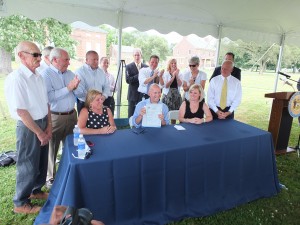Governor Jack Markell signs House Bill 310 to create Fort DuPont Redevelopment and Preservation Corporation
Former Governor Jack Markell (2009-2017) | Newsroom | Office of the Governor | Date Posted: Wednesday, July 23, 2014
Former Governor Jack Markell (2009-2017) | Newsroom | Office of the Governor | Date Posted: Wednesday, July 23, 2014
FORT DUPONT STATE PARK – Surrounded by supporters, area legislators, and Delaware City officials, Governor Jack Markell signed legislation to advance the revitalization of what he called “one of the most underutilized sites in the state.”

House Substitute 1 to House Bill 310, sponsored by Representative Valerie Longhurst (D-Delaware City, Bear) and Senator Nicole Poore (D-Delaware City, New Castle), creates the Fort DuPont Redevelopment and Preservation Corporation to spearhead the renovation, redevelopment and preservation of the Fort DuPont complex.
“Fort DuPont’s rich history, distinctive architecture, and abundant natural resources serve as a solid foundation for the site’s rebirth,” said Governor Jack Markell. “By strategically breathing new life into the Fort DuPont complex, we can create a destination that connects with the majestic Delaware Bayshore, Fort Delaware State Park, the Michael Castle C&D Canal Trail, and the many exciting new projects now under way in Delaware City.
“We have two choices. We can abandon our history or we can restore it. And we’re here because we have chosen to do everything we can to restore it. Today we take the next major step in helping Fort DuPont reach its great potential.”
The legislation sets the stage for the reuse and rehabilitation of the underutilized former military facility, which played a role in both World Wars and housed a military community for decades. The Fort was actively used as a military base from the Civil War through World War II. The renovation, redevelopment and preservation plan was outlined in the Fort DuPont master plan unveiled last spring.
DNREC partnered with Delaware City to coordinate a diverse group of state and local stakeholders and community members who worked together since 2012 to develop a master plan, which aims to preserve the site’s historic buildings and landscapes while accommodating new private sector and institutional uses to reactivate the site and promote economic progress for current and future generations. The new Fort DuPont Redevelopment and Preservation Corporation will oversee the master plan’s implementation.

“Fort DuPont has played an important role in Delaware’s history and this legislation will help assure that this site does not fall victim to neglect,” said DNREC Secretary David S. Small. “This legislation builds on the strong and innovative partnerships that were developed during the creation of the master plan which provides a framework for potential limited development and improved resiliency of the site.”
The master plan focuses on reuse and redevelopment strategies for the portion of the Fort DuPont Complex located northeast of Route 9. The Fort DuPont property is distinguished by its extraordinary waterfront location, its network of riverside trails, recreational amenities, and historic buildings and landscapes. It occupies a strategic location within the state and region as the northern gateway to the Delaware Bayshore and an anchor point on the Michael Castle Trail.
The Corporation will be comprised of an 11 member Board of Directors, including the Cabinet Secretaries of Department of Natural Resources and Environmental Control, the Department of Health and Social Services, and the Department of State, or their designees. In addition, the Office of State Planning and Controller General will have spots along with four appointees from the Mayor and Council of Delaware City. The Governor will appoint a chair. The law also provides for a 13 member Advisory Council that will assist the Board in carrying out its duties through specific expertise in areas such as historic preservation, parks and recreation, and real estate.
“This project will be such a gem for the area and will preserve a wonderful legacy at Fort DuPont,” said Longhurst. “It also sets the groundwork for a transformation or expansion of the Governor Bacon Health Complex to grow to meet the demands of the region in the 21st century.”
The master plan establishes a shared community vision and implementation strategy to evolve Fort DuPont into a model “live-work-learn-play-visit” community. It emphasizes expanding recreational opportunities, restoring wildlife habitat, restoring historic buildings, removing blight and creating opportunities to increase tourism. This long-term vision for the reuse of Fort DuPont builds upon the site’s National Historic District status, the existing assets of the park, and the area’s cultural, natural and recreational amenities.
“When you walk around the area at Fort DuPont and Governor Bacon Health Center, you can’t help but take in the great history of this place and its immense promise for the future,” said Poore. “It’s our hope that this plan will allow us to develop an asset to the Delaware City community that both realizes its economic potential and respects its historical significance.”
The plan also calls for significant analysis of the hydrology of the site, which has experienced challenges from flooding in the past. Any future development of the complex will be required to meet strict standards of flood plain management and sea level rise adaptation.
The 325-acre complex, designated as a National Historic District, is located along the Delaware River and is delineated by the Chesapeake and Delaware Canal on the south and the Branch Canal, currently separating it from Delaware City on the north. It includes Fort DuPont State Park, Governor Bacon Health Center, and a complex of state-owned buildings and residences.
Fort Delaware State Park sits across from the property on Pea Patch Island in the Delaware Bay. The final draft of the Fort DuPont master plan is available for review or download on the DNREC website.
Keep up to date by receiving a daily digest email, around noon, of current news release posts from state agencies on news.delaware.gov.
Here you can subscribe to future news updates.
Former Governor Jack Markell (2009-2017) | Newsroom | Office of the Governor | Date Posted: Wednesday, July 23, 2014
FORT DUPONT STATE PARK – Surrounded by supporters, area legislators, and Delaware City officials, Governor Jack Markell signed legislation to advance the revitalization of what he called “one of the most underutilized sites in the state.”

House Substitute 1 to House Bill 310, sponsored by Representative Valerie Longhurst (D-Delaware City, Bear) and Senator Nicole Poore (D-Delaware City, New Castle), creates the Fort DuPont Redevelopment and Preservation Corporation to spearhead the renovation, redevelopment and preservation of the Fort DuPont complex.
“Fort DuPont’s rich history, distinctive architecture, and abundant natural resources serve as a solid foundation for the site’s rebirth,” said Governor Jack Markell. “By strategically breathing new life into the Fort DuPont complex, we can create a destination that connects with the majestic Delaware Bayshore, Fort Delaware State Park, the Michael Castle C&D Canal Trail, and the many exciting new projects now under way in Delaware City.
“We have two choices. We can abandon our history or we can restore it. And we’re here because we have chosen to do everything we can to restore it. Today we take the next major step in helping Fort DuPont reach its great potential.”
The legislation sets the stage for the reuse and rehabilitation of the underutilized former military facility, which played a role in both World Wars and housed a military community for decades. The Fort was actively used as a military base from the Civil War through World War II. The renovation, redevelopment and preservation plan was outlined in the Fort DuPont master plan unveiled last spring.
DNREC partnered with Delaware City to coordinate a diverse group of state and local stakeholders and community members who worked together since 2012 to develop a master plan, which aims to preserve the site’s historic buildings and landscapes while accommodating new private sector and institutional uses to reactivate the site and promote economic progress for current and future generations. The new Fort DuPont Redevelopment and Preservation Corporation will oversee the master plan’s implementation.

“Fort DuPont has played an important role in Delaware’s history and this legislation will help assure that this site does not fall victim to neglect,” said DNREC Secretary David S. Small. “This legislation builds on the strong and innovative partnerships that were developed during the creation of the master plan which provides a framework for potential limited development and improved resiliency of the site.”
The master plan focuses on reuse and redevelopment strategies for the portion of the Fort DuPont Complex located northeast of Route 9. The Fort DuPont property is distinguished by its extraordinary waterfront location, its network of riverside trails, recreational amenities, and historic buildings and landscapes. It occupies a strategic location within the state and region as the northern gateway to the Delaware Bayshore and an anchor point on the Michael Castle Trail.
The Corporation will be comprised of an 11 member Board of Directors, including the Cabinet Secretaries of Department of Natural Resources and Environmental Control, the Department of Health and Social Services, and the Department of State, or their designees. In addition, the Office of State Planning and Controller General will have spots along with four appointees from the Mayor and Council of Delaware City. The Governor will appoint a chair. The law also provides for a 13 member Advisory Council that will assist the Board in carrying out its duties through specific expertise in areas such as historic preservation, parks and recreation, and real estate.
“This project will be such a gem for the area and will preserve a wonderful legacy at Fort DuPont,” said Longhurst. “It also sets the groundwork for a transformation or expansion of the Governor Bacon Health Complex to grow to meet the demands of the region in the 21st century.”
The master plan establishes a shared community vision and implementation strategy to evolve Fort DuPont into a model “live-work-learn-play-visit” community. It emphasizes expanding recreational opportunities, restoring wildlife habitat, restoring historic buildings, removing blight and creating opportunities to increase tourism. This long-term vision for the reuse of Fort DuPont builds upon the site’s National Historic District status, the existing assets of the park, and the area’s cultural, natural and recreational amenities.
“When you walk around the area at Fort DuPont and Governor Bacon Health Center, you can’t help but take in the great history of this place and its immense promise for the future,” said Poore. “It’s our hope that this plan will allow us to develop an asset to the Delaware City community that both realizes its economic potential and respects its historical significance.”
The plan also calls for significant analysis of the hydrology of the site, which has experienced challenges from flooding in the past. Any future development of the complex will be required to meet strict standards of flood plain management and sea level rise adaptation.
The 325-acre complex, designated as a National Historic District, is located along the Delaware River and is delineated by the Chesapeake and Delaware Canal on the south and the Branch Canal, currently separating it from Delaware City on the north. It includes Fort DuPont State Park, Governor Bacon Health Center, and a complex of state-owned buildings and residences.
Fort Delaware State Park sits across from the property on Pea Patch Island in the Delaware Bay. The final draft of the Fort DuPont master plan is available for review or download on the DNREC website.
Keep up to date by receiving a daily digest email, around noon, of current news release posts from state agencies on news.delaware.gov.
Here you can subscribe to future news updates.